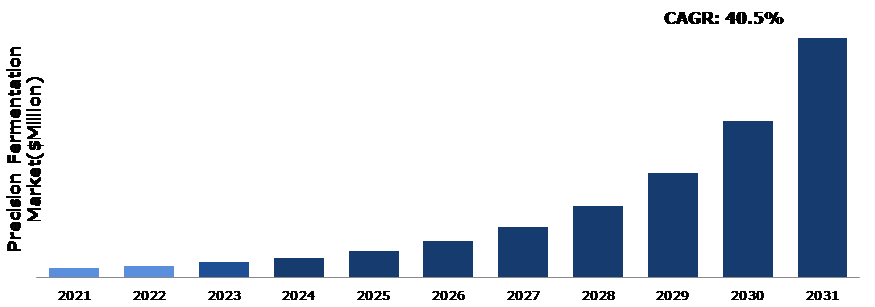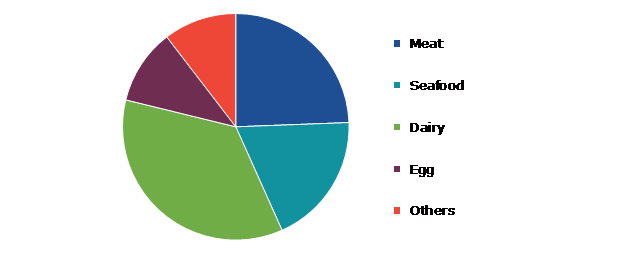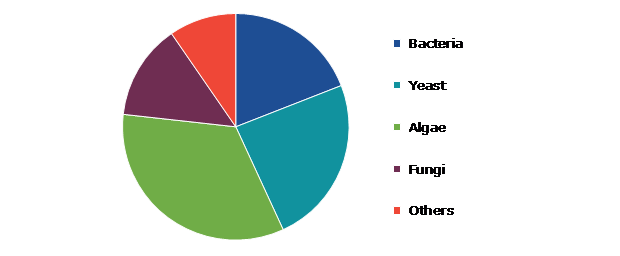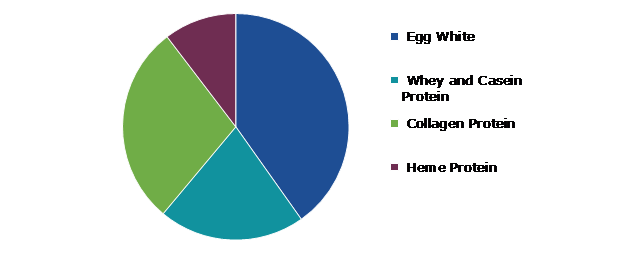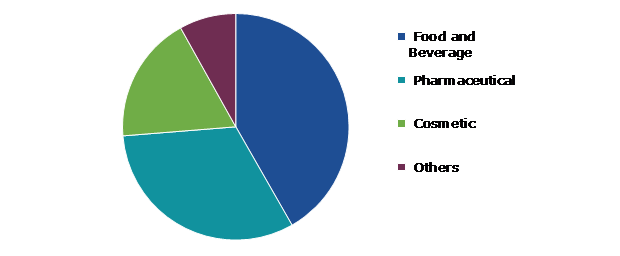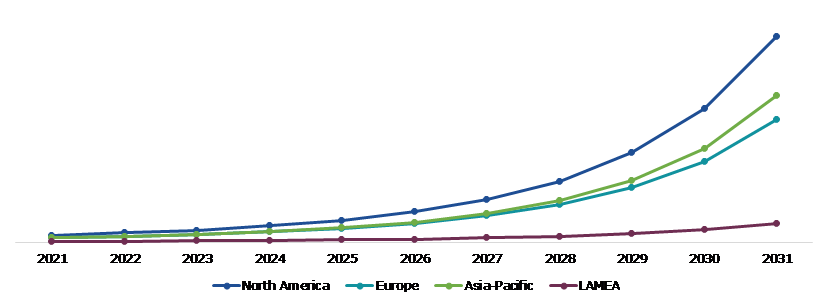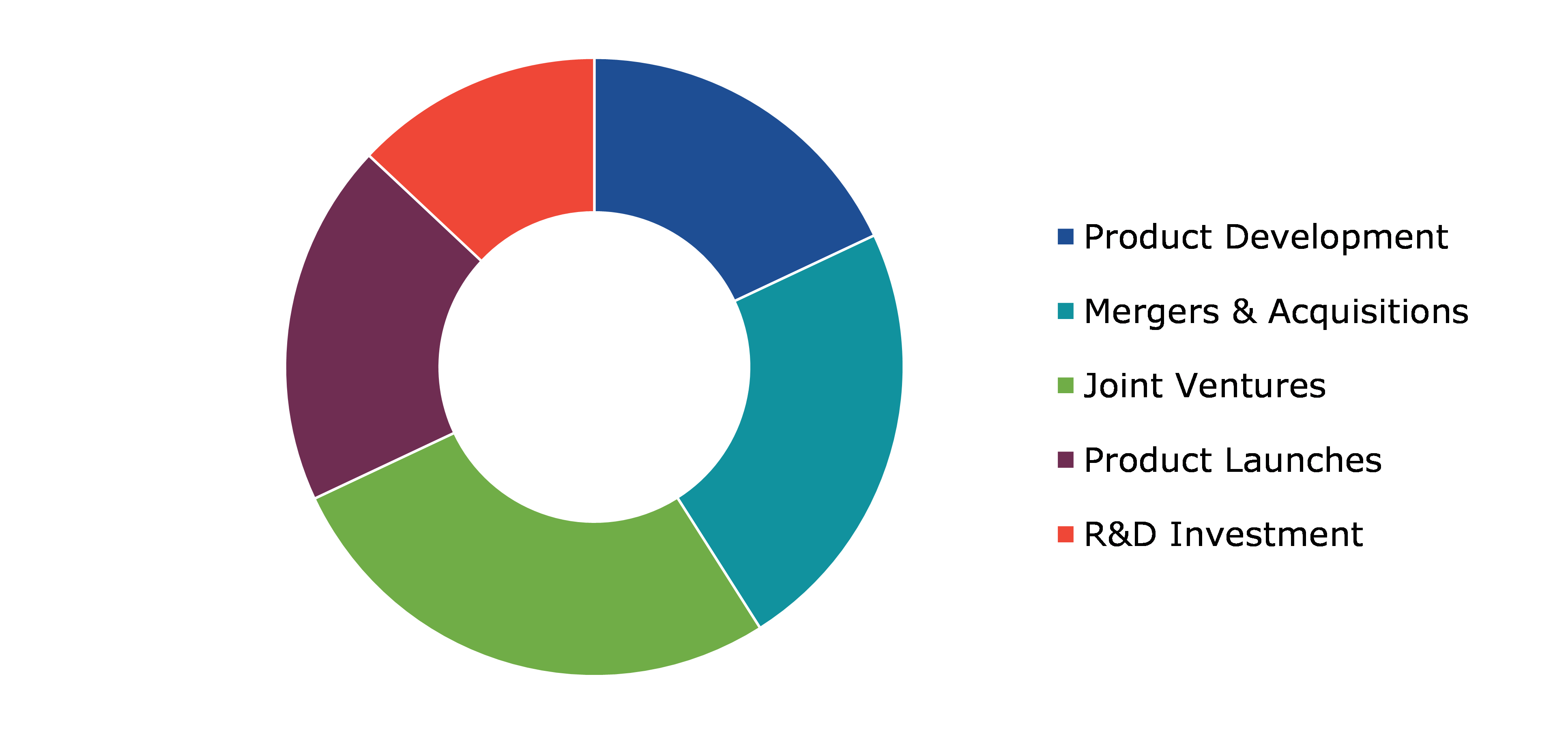Global Precision Fermentation Market Report
RA08650
Global Precision Fermentation Market by Application (Meat, Seafood, Dairy, Egg and Others), Microbe (Bacteria, Yeast, Algae, Fungi, and Others), Ingredient (Egg White, Whey and Casein Protein, Collagen Protein, and Heme Protein), End User (Food and Beverage, Pharmaceutical, Cosmetic, and Others), and Region (North America, Europe, Asia-Pacific, and LAMEA): Global Opportunity Analysis and Industry Forecast 2022–2031
Global Precision Fermentation Market Analysis
The Global Precision Fermentation Market Size was $1,277.8 million in 2021 and is predicted to grow with a CAGR of 40.5%, by generating a revenue of $34,868.1 million by 2031.
Global Precision Fermentation Market Synopsis
Precision fermentation technology is used in environmentally friendly cosmetic and personal care products. Fermentation ingredients such as amino acids, polymers, industrial enzymes, and others are being used by personal care ingredient manufacturers to develop new products and processes such as high bioavailability actives, bioconversion of fragrance to water-soluble natural fragrance, whitening, bioactive for anti-aging, and moisturizing, UV-blocking effect. Additionally, the pharmaceutical business is utilizing precious fermentation products in the development of new concepts and products utilizing specialty components. Vitamins, and amino acids, as well as industrial enzymes, are extensively used as fermented components in the pharmaceutical industry for applications such as antiviral medications, therapeutic recombinant proteins and DNA, and pharmaceutical formulations. These factors are anticipated to boost the precious fermentation industry growth in the upcoming years.
However, some of the disadvantages of precision fermentation include high cost of technology and chemical use for fermentation such as lactic acid used for fermentation is costly, which limits its use in the dairy industry. This factor is expected to hamper the growth of the precision fermentation market throughout the forecast period.
Rising demand for protein across the globe, changing preferences and tastes of consumers, and rise in the number of both advancements and investments are some of the key drivers propelling the development within the global precision fermentation market. Additionally, increasing preference and acceptance of meat-free and vegan lifestyles is also driving demand in the global precision fermentation market. These trends can be attributed to an increase in consumer awareness of unfair and cruel treatment of animals in the food industry, as well as the growing vegan population. These factors are driving the excellent opportunity for the market during the upcoming year.
According to regional analysis, the North America precision fermentation market accounted a dominating market share in 2021. This is because in the US, the need for high-quality fermented foods is expanding in tandem with rising consumer disposable income, a growing population, and a growing demand for precision fermentation.
Precision Fermentation Overview
Precision fermentation is the process of producing complex organic compounds using biological microbes. It is a new food technology that is entering the marketplace. Precision fermentation uses microbial hosts as "cell factories" for the production of specialized functional components that have higher purity standards than main protein ingredients and are integrated at lower quantities. These ingredients typically require greater purity than the primary protein ingredients and are incorporated at much lower levels. These functional ingredients can improve sensory characteristics and functional attributes of plant-based products or cultivated meat. Precision fermentation can produce enzymes, flavoring agents, vitamins, natural pigments, and fats.
COVID-19 Impact on Global Precision Fermentation Market
The COVID-19 pandemic delivered a significant impact on various businesses all over the world. One of the most affected industries due to the pandemic was the food and beverage industry. As a result of supply chain disruptions, facility closures, and a global economic slowdown, demand for precision fermentation decreased. Moreover, import-export restrictions were imposed on significant precision fermentation manufacturing nations such as the United States and China. For instance, sanitization of goods being exported from China was imposed by several countries. In addition, the food and beverages sector faced the highest impact in terms of sales and acquisition of new projects due to which the protein demand reduced significantly. The pandemic impacted the manufacture of precision fermentation products, and the demand for processed food substantially dropped. The lockdown imposed by several governments within their countries played a major role in hampering food production and distribution. The precision fermentation industry was also devastated as a consequence of the impacted food and beverage sector. While individuals were advised to stay home by governments during the early stages of the pandemic, only the food and beverage supermarkets and grocery stores across the country were open. Customers avoided going out, going out to eat, and going to crowded supermarkets and other places to eat and drink. Consumer products companies that sell food and beverages witnessed a sharp decline in sales and disruptions in their supply networks. Out-of-home consumption, that historically generated the biggest profit margin, decreased as at-home consumption increased. However, in order to maintain the inventories for a longer period of time, the demand for precision fermentation products remained constant.
Rising Investment in Precision Fermentation Technology as well as Growing Consumer Preference for Plant Based Meat to Drive Market Growth
One of the major factors driving the growth of the precision fermentation industry is the shift in consumer preferences towards plant-based protein and shifting eating habits. In addition to animal proteins derived from plants, animal proteins may also be synthesized through fermentation techniques. In precise fermentation, bioreactors serve as microbial hosts. These bacteria produce a variety of useful components, including enzymes present in proteins, flavorings, vitamins, natural colors, and so on. Precision fermentation, because of its distinct manufacturing properties, also allows for the production of pure forms of protein. Precision farming results in the production of more effective proteins and other organic compounds that are processed at minor quantities.
To know more about global precision fermentation market drivers, get in touch with our analysts here.
The High Cost of Producing Protein Ingredients Using Precision Fermentation to Restrict Market Growth
Precision fermentation for the production of animal-free protein or fats has gained traction as a result of the growing vegan population's demand for animal-free products. In this approach, yeast bacteria such as bacteria or fungus are genetically caused to produce the genetic factor that is normally encoded by animal DNA. These microbes are then used to produce a desirable product that mimics the texture, and nutritional profile of real animal products. For instance, every company that produces animal-free egg white uses genetically modified yeast cells. Additionally, precision fermentation has various benefits, including reduced land water consumption, greenhouse gas emissions, and health issues connected with animal-based products, all of which are expected to hinder the precision fermentation market's growth.
Development of Novel Protein Production System to Drive Excellent Opportunities
Identifying innovative protein-generation approaches through focused R&D and infrastructure investment will remain critical in capturing value, optimizing resources, and establishing precision fermentation competitive advantages. Various new protein production systems are being scaled up and industrialized in order to generate animal-free meat and microalgae and to use novel and unusual feedstock such as CO2. These innovative production techniques are likely to become as important as traditional food systems.
To know more about global precision fermentation market opportunities, get in touch with our analysts here.
Global Precision Fermentation Market, by Application
Based on application, the market has been divided into meat, seafood, dairy, egg and others. Among these, the dairy sub-segment accounted for the highest market share in 2021, whereas the meat sub-segment is estimated to show the fastest growth during the forecast period.
Global Precision Fermentation Market Size, by Application, 2021
Source: Research Dive Analysis
The dairy sub-type accounted for a dominating market share in 2021. Dairy products are one of the precision fermentation's most attractive potential uses. The majority of companies that have been successful in producing dairy plant-based cheese products, such as Treeline and Miyoko's, have done it over cream fermentation. Several companies have also surfaced to produce dairy fats and proteins that would bring in a wave of plant-based, fermentation-enabled dairy, including New Culture, Change Foods, Cultivated, and Legen Dairy.
The meat sub-type is anticipated to show the fastest growth during the forecast period. The demand for plant-based proteins in the meat alternatives category is expected to rise significantly in the coming years, as the global plant-based meat industry expands significantly. Precision-fermented meat-alternative burgers, fats, and proteins have been introduced by companies such as Impossible Foods, and Melt & Marble, which is projected to drive the growth of the meat & seafood category in the precision fermentation market.
Global Precision Fermentation Market, by Microbe
Based on microbe, the market has been divided into bacteria, yeast, algae, fungi, and others. Among these, the algae sub-segment accounted a dominating market share in 2021.
Global Precision Fermentation Market Share, by Microbe, 2021
Source: Research Dive Analysis
The algae sub-segment accounted a dominating market share in 2021. Algal cultivation is complex and requires optimization to achieve large biomass yields. Algal biomass production is affected by nutrient intake as well as other environmental factors like temperature, pH, salt content, and so on. Algae are also being researched for gaseous fermentations to produce high value chemicals and also for upgradation of biogas. Additionally, the concept of eating algae has been around for more than fifty years. As a substitute protein source, it has not been very popular among consumers.
Global Precision Fermentation Market, by Ingredient
Based on ingredient, the market has been divided into egg white, whey and casein protein, collagen protein, and heme protein. Among these, the egg white sub-segment is accounted a dominating market share.
Global Precision Fermentation Market Growth, by Ingredient, 2021
Source: Research Dive Analysis
The egg white sub-segment accounted a dominating market share in 2021. The demand for plant-based egg and dairy alternatives has increased in recent years across a variety of food types and applications. Several factors have contributed to the development, including sustainability, allergenicity, and consumer movements towards flexitarian diets. The opting of egg white substitutes is motivated by a number of variables, some of which are more important for customers and others of key significance to food producers.
Global Precision Fermentation Market, by End User
By end user, the market has been divided into food and beverage, pharmaceutical, cosmetic, and others. Among these, the food and beverage sub-segment is accounted a dominating market share in 2021.
Global Precision Fermentation Market Forecast, by End User, 2021
Source: Research Dive Analysis
The food and beverage sub-segment accounted a dominating market share in 2021. Fermented foods & beverages products have been associated with several favorable health effects, including improved digestive health, higher immunity, and greater nutritional availability.. Fermented substances may be found in a variety of foods and drinks, such as beer, bread, yoghurt, and cheese. Fermented amino acids, specially, are extensively utilized in food products, and different amino acids provide diverse flavors to the food products in which they are used. The increasing usage of fermented items in bakeries and dairy products is expected to increase global demand for fermented food and beverage products. With the advancement of microbiology and biotechnology, the demand for precision fermentation products has resulted in the rise of a new sector the food and beverage industry.
Global Precision Fermentation Market, Regional Insights
The precision fermentation market was investigated across North America, Europe, Asia-Pacific, and LAMEA.
Global Precision Fermentation Market Size & Forecast, by Region, 2021-2031 (USD Million)
Source: Research Dive Analysis
The Market for Precision Fermentation in North America was the Most Dominant
The North American precision fermentation market accounted a dominating market share. Increasing awareness of the health advantages of eating healthy and vegan food items, as well as an increase in the trend of weight control and veganism among regional consumers, are driving the growth of the North American precision fermentation market. Additionally, reduced meat consumption and the resultant increase in consumption of meat substitute products is assisting in market development. Furthermore, rising demand for protein products derived from precision fermentation processes for applications such as dairy alternatives, meet extenders, and meat analogues is driving expansion in this regional market.
Competitive Scenario in the Global Precision Fermentation Market
Investment and agreement are common strategies followed by major market players. For instance, in Dec-2021 HEMAMI, a plant-based protein, was launched by Motif Food Works. By precise fermentation, the new product aims to add a meaty fragrance as well as umami flavor to sausages, burgers, and other plant-based meat alternatives.
Source: Research Dive Analysis
Some of the leading precision fermentation market players are geltor inc., Imagindairy Ltd, Change Foods, Eden Brew, Impossible Foods Inc, Motif Foodworks, Inc, Nourish Ingredients, Shiru Inc, FUMI Ingredients, and Perfect Day Inc
| Aspect | Particulars |
| Historical Market Estimations | 2020 |
| Base Year for Market Estimation | 2021 |
| Forecast Timeline for Market Projection | 2022-2031 |
| Geographical Scope | North America, Europe, Asia-Pacific, LAMEA |
| Segmentation by Application |
|
| Segmentation by Microbe |
|
| Segmentation by Ingredient |
|
| Segmentation by End User |
|
| Key Companies Profiled |
|
Q1. What is the size of the global precision fermentation market?
A. The size of the global precision fermentation market was over $1,277.8 million in 2021 and is projected to reach $34,868.1 million by 2031.
Q2. Which are the major companies in the precision fermentation market?
A. geltor inc., Imagindairy Ltd, Change Foods are some of the key players in the global precision fermentation market.
Q3. Which region, among others, possesses greater investment opportunities in the near future?
A. The Asia-Pacific region possesses great investment opportunities for investors to witness the most promising growth in the future.
Q4. What will be the growth rate of the Asia-Pacific precision fermentation market?
A. Asia-Pacific precision fermentation market is anticipated to grow at 42.4% CAGR during the forecast period.
Q5. What are the strategies opted by the leading players in this market?
A. Agreement and investment are the two key strategies opted by the operating companies in this market.
Q6. Which companies are investing more on R&D practices?
A. geltor inc., Imagindairy Ltd, Change Foods, Eden Brew, Impossible Foods Inc are the companies investing more on R&D activities for developing new products and technologies.
1.Research Methodology
1.1.Desk Research
1.2.Real time insights and validation
1.3.Forecast model
1.4.Assumptions and forecast parameters
1.5.Market size estimation
1.5.1.Top-down approach
1.5.2.Bottom-up approach
2.Report Scope
2.1.Market definition
2.2.Key objectives of the study
2.3.Report overview
2.4.Market segmentation
2.5.Overview of the impact of COVID-19 on Global Precision Fermentation Market
3.Executive Summary
4.Market Overview
4.1.Introduction
4.2.Growth impact forces
4.2.1.Drivers
4.2.2.Restraints
4.2.3.Opportunities
4.3.Market value chain analysis
4.3.1.List of raw material suppliers
4.3.2.List of manufacturers
4.3.3.List of distributors
4.4.Innovation & sustainability matrices
4.4.1.Application matrix
4.4.2.Regulatory matrix
4.5.Porter’s five forces analysis
4.5.1.Bargaining power of suppliers
4.5.2.Bargaining power of consumers
4.5.3.Threat of substitutes
4.5.4.Threat of new entrants
4.5.5.Competitive rivalry intensity
4.6.PESTLE analysis
4.6.1.Political
4.6.2.Economical
4.6.3.Social
4.6.4.Technological
4.6.5.Environmental
4.7.Impact of COVID-19 on Precision Fermentation Market
4.7.1.Pre-covid market scenario
4.7.2.Post-covid market scenario
5.Precision Fermentation Market Analysis, by Application
5.1.Overview
5.2.Meat
5.2.1.Definition, key trends, growth factors, and opportunities
5.2.2.Market size analysis, by region, 2021-2031
5.2.3.Market share analysis, by country, 2021-2031
5.3.Seafood
5.3.1.Definition, key trends, growth factors, and opportunities
5.3.2.Market size analysis, by region, 2021-2031
5.3.3.Market share analysis, by country, 2021-2031
5.4.Dairy
5.4.1.Definition, key trends, growth factors, and opportunities
5.4.2.Market size analysis, by region, 2021-2031
5.4.3.Market share analysis, by country, 2021-2031
5.5.Egg
5.5.1.Definition, key trends, growth factors, and opportunities
5.5.2.Market size analysis, by region, 2021-2031
5.5.3.Market share analysis, by country, 2021-2031
5.6.Others
5.6.1.Definition, key trends, growth factors, and opportunities
5.6.2.Market size analysis, by region, 2021-2031
5.6.3.Market share analysis, by country, 2021-2031
5.7.Research Dive Exclusive Insights
5.7.1.Market attractiveness
5.7.2.Competition heatmap
6.Precision Fermentation Market Analysis, by Microbe
6.1.Overview
6.2.Bacteria
6.2.1.Definition, key trends, growth factors, and opportunities
6.2.2.Market size analysis, by region, 2021-2031
6.2.3.Market share analysis, by country, 2021-2031
6.3.Yeast
6.3.1.Definition, key trends, growth factors, and opportunities
6.3.2.Market size analysis, by region, 2021-2031
6.3.3.Market share analysis, by country, 2021-2031
6.4.Algae
6.4.1.Definition, key trends, growth factors, and opportunities
6.4.2.Market size analysis, by region, 2021-2031
6.4.3.Market share analysis, by country, 2021-2031
6.5.Fungi
6.5.1.Definition, key trends, growth factors, and opportunities
6.5.2.Market size analysis, by region, 2021-2031
6.5.3.Market share analysis, by country, 2021-2031
6.6.Others
6.6.1.Definition, key trends, growth factors, and opportunities
6.6.2.Market size analysis, by region, 2021-2031
6.6.3.Market share analysis, by country, 2021-2031
6.7.Research Dive Exclusive Insights
6.7.1.Market attractiveness
6.7.2.Competition heatmap
7. Precision Fermentation Market Analysis, by Ingredient
7.1.Overview
7.2.Egg White
7.2.1.Definition, key trends, growth factors, and opportunities
7.2.2.Market size analysis, by region, 2021-2031
7.2.3.Market share analysis, by country, 2021-2031
7.3.Whey and Casein Protein
7.3.1.Definition, key trends, growth factors, and opportunities
7.3.2.Market size analysis, by region, 2021-2031
7.3.3.Market share analysis, by country, 2021-2031
7.4.Collagen Protein
7.4.1.Definition, key trends, growth factors, and opportunities
7.4.2.Market size analysis, by region, 2021-2031
7.4.3.Market share analysis, by country, 2021-2031
7.5.Heme Protein
7.5.1.Definition, key trends, growth factors, and opportunities
7.5.2.Market size analysis, by region, 2021-2031
7.5.3.Market share analysis, by country, 2021-2031
7.6.Research Dive Exclusive Insights
7.6.1.Market attractiveness
7.6.2.Competition heatmap
8.Precision Fermentation Market Analysis, by End User
8.1.Overview
8.2.Food and Beverage
8.2.1.Definition, key trends, growth factors, and opportunities
8.2.2.Market size analysis, by region, 2021-2031
8.2.3.Market share analysis, by country, 2021-2031
8.3.Pharmaceutical
8.3.1.Definition, key trends, growth factors, and opportunities
8.3.2.Market size analysis, by region, 2021-2031
8.3.3.Market share analysis, by country, 2021-2031
8.4.Cosmetic
8.4.1.Definition, key trends, growth factors, and opportunities
8.4.2.Market size analysis, by region, 2021-2031
8.4.3.Market share analysis, by country, 2021-2031
8.5.Others
8.5.1.Definition, key trends, growth factors, and opportunities
8.5.2.Market size analysis, by region, 2021-2031
8.5.3.Market share analysis, by country, 2021-2031
8.6.Research Dive Exclusive Insights
8.6.1.Market attractiveness
8.6.2.Competition heatmap
9.Precision Fermentation Market, by Region
9.1.North America
9.1.1.U.S.
9.1.1.1.Market size analysis, by Application, 2021-2031
9.1.1.2.Market size analysis, by Microbe, 2021-2031
9.1.1.3.Market size analysis, by Ingredient, 2021-2031
9.1.1.4.Market size analysis, by End User, 2021-2031
9.1.2.Canada
9.1.2.1.Market size analysis, by Application, 2021-2031
9.1.2.2.Market size analysis, by Microbe, 2021-2031
9.1.2.3.Market size analysis, by Ingredient, 2021-2031
9.1.2.4.Market size analysis, by End User, 2021-2031
9.1.3.Mexico
9.1.3.1.Market size analysis, by Application, 2021-2031
9.1.3.2.Market size analysis, by Microbe, 2021-2031
9.1.3.3.Market size analysis, by Ingredient, 2021-2031
9.1.3.4.Market size analysis, by End User, 2021-2031
9.1.4.Research Dive Exclusive Insights
9.1.4.1.Market attractiveness
9.1.4.2.Competition heatmap
9.2.Europe
9.2.1.Germany
9.2.1.1.Market size analysis, by Application, 2021-2031
9.2.1.2.Market size analysis, by Microbe, 2021-2031
9.2.1.3.Market size analysis, by Ingredient, 2021-2031
9.2.1.4.Market size analysis, by End User, 2021-2031
9.2.2.UK
9.2.2.1.Market size analysis, by Application, 2021-2031
9.2.2.2.Market size analysis, by Microbe, 2021-2031
9.2.2.3.Market size analysis, by Ingredient, 2021-2031
9.2.2.4.Market size analysis, by End User, 2021-2031
9.2.3.France
9.2.3.1.Market size analysis, by Application, 2021-2031
9.2.3.2.Market size analysis, by Microbe, 2021-2031
9.2.3.3.Market size analysis, by Ingredient, 2021-2031
9.2.3.4.Market size analysis, by End User, 2021-2031
9.2.4.Spain
9.2.4.1.Market size analysis, by Application, 2021-2031
9.2.4.2.Market size analysis, by Microbe, 2021-2031
9.2.4.3.Market size analysis, by Ingredient, 2021-2031
9.2.4.4.Market size analysis, by End User, 2021-2031
9.2.5.Italy
9.2.5.1.Market size analysis, by Application, 2021-2031
9.2.5.2.Market size analysis, by Microbe, 2021-2031
9.2.5.3.Market size analysis, by Ingredient, 2021-2031
9.2.5.4.Market size analysis, by End User, 2021-2031
9.2.6.Rest of Europe
9.2.6.1.Market size analysis, by Application, 2021-2031
9.2.6.2.Market size analysis, by Microbe, 2021-2031
9.2.6.3.Market size analysis, by Ingredient, 2021-2031
9.2.6.4.Market size analysis, by End User, 2021-2031
9.2.7.Research Dive Exclusive Insights
9.2.7.1.Market attractiveness
9.2.7.2.Competition heatmap
9.3.Asia-Pacific
9.3.1.China
9.3.1.1.Market size analysis, by Application, 2021-2031
9.3.1.2.Market size analysis, by Microbe, 2021-2031
9.3.1.3.Market size analysis, by Ingredient, 2021-2031
9.3.1.4.Market size analysis, by End User, 2021-2031
9.3.2.Japan
9.3.2.1.Market size analysis, by Application, 2021-2031
9.3.2.2.Market size analysis, by Microbe, 2021-2031
9.3.2.3.Market size analysis, by Ingredient, 2021-2031
9.3.2.4.Market size analysis, by End User, 2021-2031
9.3.3.India
9.3.3.1.Market size analysis, by Application, 2021-2031
9.3.3.2.Market size analysis, by Microbe, 2021-2031
9.3.3.3.Market size analysis, by Ingredient, 2021-2031
9.3.3.4.Market size analysis, by End User, 2021-2031
9.3.4.Australia
9.3.4.1.Market size analysis, by Application, 2021-2031
9.3.4.2.Market size analysis, by Microbe, 2021-2031
9.3.4.3.Market size analysis, by Ingredient, 2021-2031
9.3.4.4.Market size analysis, by End User, 2021-2031
9.3.5.South Korea
9.3.5.1.Market size analysis, by Application, 2021-2031
9.3.5.2.Market size analysis, by Microbe, 2021-2031
9.3.5.3.Market size analysis, by Ingredient, 2021-2031
9.3.5.4.Market size analysis, by End User, 2021-2031
9.3.6.Rest of Asia-Pacific
9.3.6.1.Market size analysis, by Application, 2021-2031
9.3.6.2.Market size analysis, by Microbe, 2021-2031
9.3.6.3.Market size analysis, by Ingredient, 2021-2031
9.3.6.4.Market size analysis, by End User, 2021-2031
9.3.7.Research Dive Exclusive Insights
9.3.7.1.Market attractiveness
9.3.7.2.Competition heatmap
9.4.LAMEA
9.4.1.Brazil
9.4.1.1.Market size analysis, by Application, 2021-2031
9.4.1.2.Market size analysis, by Microbe, 2021-2031
9.4.1.3.Market size analysis, by Ingredient, 2021-2031
9.4.1.4.Market size analysis, by End User, 2021-2031
9.4.2.Saudi Arabia
9.4.2.1.Market size analysis, by Application, 2021-2031
9.4.2.2.Market size analysis, by Microbe, 2021-2031
9.4.2.3.Market size analysis, by Ingredient, 2021-2031
9.4.2.4.Market size analysis, by End User, 2021-2031
9.4.3.UAE
9.4.3.1.Market size analysis, by Application, 2021-2031
9.4.3.2.Market size analysis, by Microbe, 2021-2031
9.4.3.3.Market size analysis, by Ingredient, 2021-2031
9.4.3.4.Market size analysis, by End User, 2021-2031
9.4.4.South Africa
9.4.4.1.Market size analysis, by Application, 2021-2031
9.4.4.2.Market size analysis, by Microbe, 2021-2031
9.4.4.3.Market size analysis, by Ingredient, 2021-2031
9.4.4.4.Market size analysis, by End User, 2021-2031
9.4.5.Rest of LAMEA
9.4.5.1.Market size analysis, by Application, 2021-2031
9.4.5.2.Market size analysis, by Microbe, 2021-2031
9.4.5.3.Market size analysis, by Ingredient, 2021-2031
9.4.5.4.Market size analysis, by End User, 2021-2031
9.4.6.Research Dive Exclusive Insights
9.4.6.1.Market attractiveness
9.4.6.2.Competition heatmap
10.Competitive Landscape
10.1.Top winning strategies, 2021
10.1.1.By strategy
10.1.2.By year
10.2.Strategic overview
10.3.Market share analysis, 2021
11.Company Profiles
11.1.geltor inc.
11.1.1.Overview
11.1.2.Business segments
11.1.3.Product portfolio
11.1.4.Financial performance
11.1.5.Recent developments
11.1.6.SWOT analysis
11.1.7.Research Dive Analyst View
11.2. Imagindairy Ltd
11.2.1.Overview
11.2.2.Business segments
11.2.3.Product portfolio
11.2.4.Financial performance
11.2.5.Recent developments
11.2.6.SWOT analysis
11.2.7.Research Dive Analyst View
11.3.Change Foods
11.3.1.Overview
11.3.2.Business segments
11.3.3.Product portfolio
11.3.4.Financial performance
11.3.5.Recent developments
11.3.6.SWOT analysis
11.3.7.Research Dive Analyst View
11.4. Eden Brew
11.4.1.Overview
11.4.2.Business segments
11.4.3.Product portfolio
11.4.4.Financial performance
11.4.5.Recent developments
11.4.6.SWOT analysis
11.4.7.Research Dive Analyst View
11.5.Impossible Foods Inc
11.5.1.Overview
11.5.2.Business segments
11.5.3.Product portfolio
11.5.4.Financial performance
11.5.5.Recent developments
11.5.6.SWOT analysis
11.5.7.Research Dive Analyst View
11.6.Motif Foodworks, Inc
11.6.1.Overview
11.6.2.Business segments
11.6.3.Product portfolio
11.6.4.Financial performance
11.6.5.Recent developments
11.6.6.SWOT analysis
11.6.7.Research Dive Analyst View
11.7.Nourish Ingredients
11.7.1.Overview
11.7.2.Business segments
11.7.3.Product portfolio
11.7.4.Financial performance
11.7.5.Recent developments
11.7.6.SWOT analysis
11.7.7.Research Dive Analyst View
11.8.Shiru Inc
11.8.1.Overview
11.8.2.Business segments
11.8.3.Product portfolio
11.8.4.Financial performance
11.8.5.Recent developments
11.8.6.SWOT analysis
11.8.7.Research Dive Analyst View
11.9.FUMI Ingredients
11.9.1.Overview
11.9.2.Business segments
11.9.3.Product portfolio
11.9.4.Financial performance
11.9.5.Recent developments
11.9.6.SWOT analysis
11.9.7.Research Dive Analyst View
11.10.Perfect Day Inc
11.10.1.Overview
11.10.2.Business segments
11.10.3.Product portfolio
11.10.4.Financial performance
11.10.5.Recent developments
11.10.6.SWOT analysis
11.10.7.Research Dive Analyst View
12.Appendix
12.1.Parent & peer market analysis
12.2.Premium insights from industry experts
12.3.Related reports
Precision fermentation is a bio-chemical process wherein a microbe’s cell structure is used as a “factory” to produce specific products. As opposed to traditional fermentation techniques where microorganisms convert food items into fermented products, precision fermentation techniques employ the microorganisms themselves to produce specific enzymes. For this purpose, microorganisms are cultured for producing large quantities of enzymes and chemicals. These enzymes then undergo purification processes which then gives out the final product.
Forecast Analysis of the Precision Fermentation Market
In recent years, there has been an increase in the investment for development of novel protein production systems which is predicted to be the primary growth driver of the global precision fermentation market in the forecast period. Additionally, growing consumer preferences towards plant-based protein and shifting eating habits are anticipated to push the market forward. Along with this, surge in use of precision fermentation technology for manufacturing of environmentally friendly cosmetic and personal care products is projected to offer numerous growth and investment opportunities to the market in the analysis timeframe. However, the high cost of producing protein ingredients is estimated to create hurdles in the full-fledged growth of the precision fermentation market in the coming period.
Regionally, the precision fermentation market in the North America region is expected to be highly dominant by 2031. Increasing awareness of the health advantages of eating healthy and vegan food items is expected to be the leading factor behind the growth of the market.
According to the report published by Research Dive, the global precision fermentation market is expected to gather a revenue of $34,868.1 million by 2031 and grow at 40.5% CAGR in the 2022–2031 timeframe. Some prominent market players include geltor inc., Impossible Foods Inc, Shiru Inc, Imagindairy Ltd, Motif Foodworks, Inc, FUMI Ingredients, Change Foods, Nourish Ingredients, Perfect Day Inc, Eden Brew, and many others.
Covid-19 Impact on the Market
The outbreak of the Covid-19 pandemic has had a massive negative effect on almost all industries and businesses across the world. The precision fermentation market, too, faced a negative impact of the pandemic. The decline in the growth rate of the precision fermentation market was mainly on the account of disruptions in global supply chains which hampered the production cycles of various companies. The import-export restrictions across the globe further worsened the condition of the market.
Significant Market Developments
The significant companies operating in the industry are adopting numerous growth strategies & business tactics such as partnerships, collaborations, mergers & acquisitions, and launches to maintain a robust position in the overall market, thus helping the precision fermentation market to flourish. For instance:
- In December 2022, Perfect Day, a biotechnology company, announced the acquisition of Sterling Biotech Limited, a global pharmaceutical company. This acquisition is predicted to help Perfect Day to scale up its precision-fermented protein manufacturing in India and thus increase its market share in the next few years.
- In December 2022, Agronomics, a leading venture capital firm, announced that it was investing $7 million in Liberation Labs, a commercial precision fermentation company. This investment partnership by Agronomics is expected to help both the partners in the long run as they will be able to scale up their global operations and expand their presence in the market in the coming period.
- In February 2023, nine leading precision fermentation companies announced the establishment of the Precision Fermentation Alliance which aims at promoting sustainable precision fermentation techniques. This collaboration between nine companies, viz., Change Foods, Remilk, Imagindairy, Onego Bio, The EVERY Co., New Culture, Helaina, Perfect Day, and Motif FoodWorks is expected to be a gamechanger for the precision fermentation market in the near future.
Personalize this research
- Triangulate with your own data
- Request your format and definition
- Get a deeper dive on a specific application, geography, customer or competitor
- + 1-888-961-4454 Toll - Free
- support@researchdive.com

